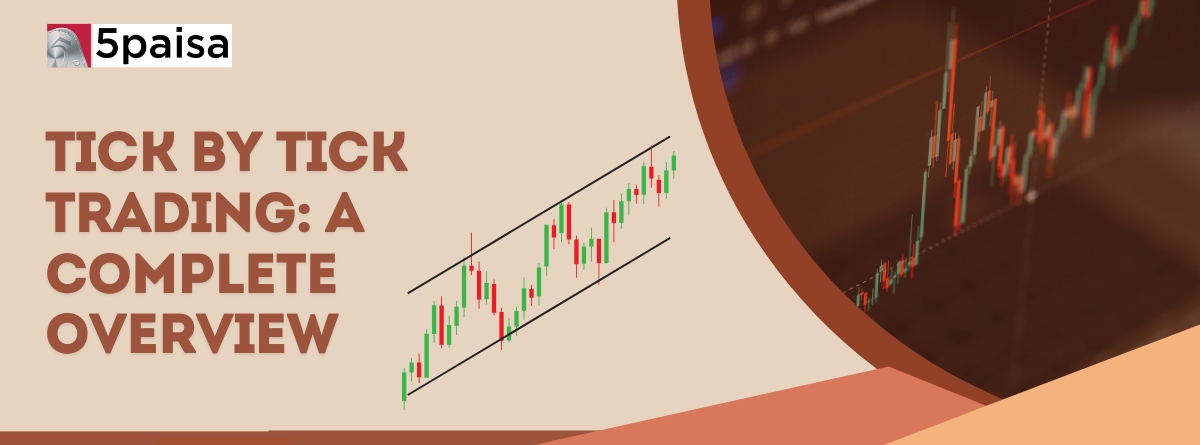Content
What is Tick by Tick Trading?
Every small change in the market, or every tick, has the power to drastically alter your choices and results. Attempting to make sense of the insane state of the market is mayhem. Hence, it becomes very important to understand what tick trading is and how it works. Before we dive into tick trading, let’s look at what a tick size is.
Unlock the full article - sign in with Gmail!
Expand Your Market Knowledge with 5paisa Articles
What is a Tick Size?
A tick size is the smallest movement any security can make. For example, if the tick size of a stock is ₹0.05, then a stock priced at ₹1000.05 can only move to ₹1000.10 or ₹999.95. In India, tick sizes are determined by the Securities and Exchange Board of India.
A tick size is important because it affects how prices move and how easily traders can buy or sell. Smaller tick sizes mean more trades, tighter price gaps, and lower costs. They work well in fast-moving markets. Bigger tick sizes are better for stable markets with slower price changes. Now that you know what a tick size is, let’s understand tick trading.
What is Tick Trading?
Tick trading also known as tick by tick trading is a strategy where traders capitalize on the smallest price movements allowed by the tick size. They focus on these tiny fluctuations to make frequent and rapid trades. This strategy is especially common in markets with strict tick size regulations such as the Indian stock market overseen by the Securities and Exchange Board of India. In tick trading traders aim to profit from the incremental changes in price dictated by the tick size, often executing a large number of trades throughout the trading day to accumulate profits based on these small movements.
Let’s take an example to understand tick by tick trading better. Ravi, an active tick trader, follows a scalping strategy. He observes a stock fluctuating between ₹220.00 and ₹220.15 throughout the day. Taking advantage of this narrow range, he repeatedly buys at ₹220.00 and sells at ₹220.15. Over the trading session, he completes 100 such trades, earning ₹0.15 per share each time. Trading 1,000 shares per order, Ravi ends the day with a profit of ₹15,000.
How does Tick Trading Work?
Tick trading or tick by tick trading focuses on profiting from small price movements by executing quick trades. Here's a breakdown of how it works:
- Analyze the Market: Traders start by tracking real-time market data using charts, indicators, and tools to spot small, quick price changes.
- Placing Quick Trades: They use fast trading platforms to place buy and sell orders instantly, reacting to even the slightest price movement.
- Earning from Small Moves: The aim is to profit from tiny price changes—like a stock moving from ₹100.00 to ₹100.05.
- Managing Risk: Since trades happen frequently, traders set strict stop-loss and take-profit levels to protect their capital and lock in gains.
Tick Trading: Advantages and Challenges
| Advantages |
Challenges |
| Traders can earn from small price moves during the day. |
Frequent trades can lead to high fees and taxes. |
| Helps increase overall market activity and liquidity. |
Small price steps can make the market more unpredictable. |
| Works well in different markets like stocks, futures, and commodities. |
Requires fast internet and advanced trading tools. |
| Stop-loss orders help limit losses and manage risks. |
The fast pace of tick trading can be stressful and mentally tiring. |
Strategies for Tick Trading
Tick by tick trading isn’t just about speed, it’s about smart decision-making. Here are some commonly used strategies:
- Scalping: This approach focuses on making many small trades to profit from tiny price differences, usually within seconds or minutes. Scalpers prefer markets with high volume and tight spreads.
- Momentum Trading: Traders follow the strength of price trends, entering trades when momentum picks up. Quick reactions to sudden price moves are key to this strategy.
- Algorithmic Trading: Automated systems are used to scan the market and place trades based on preset rules. This helps cut down on emotional decisions and speeds up execution.
- Risk and Reward Setup: Traders plan their trades with clear stop-loss and target levels based on tick movements, helping manage risks and maintain consistent returns.
Revision in Tick Sizes from April 15
Starting April 15, the NSE has revised tick sizes for certain stocks, indices, and their respective F&O contracts, based on closing prices as of March 28. While tick sizes remain unchanged for securities below ₹1,000, key changes include:
- For stocks priced between ₹1,000–₹5,000, tick size is now ₹0.10 (up from ₹0.05).
- For ₹5,000–₹10,000 stocks, it’s ₹0.50.
- ₹10,000–₹20,000 stocks now move in ₹1.00 ticks.
- Stocks above ₹20,000 have a tick size of ₹5.00.
- For indices, levels between 15,000–30,000 now have a ₹0.10 tick, and those above 30,000 move in ₹0.20 increments.
These changes impact how prices move, especially in high-value trades, so traders should adjust strategies accordingly.
Wrapping It Up: Small Ticks, Big Moves
Tick trading might seem like a game of chasing tiny moves, but for the right trader, those little ticks can add up to big gains. It’s a strategy that demands quick thinking, discipline, and the right tools. Whether you're scalping for fast profits or using algorithms for precision, success in tick by tick trading comes from understanding how every small price movement plays a role. With the right approach, those tiny market shifts have the potential to become powerful opportunities.



